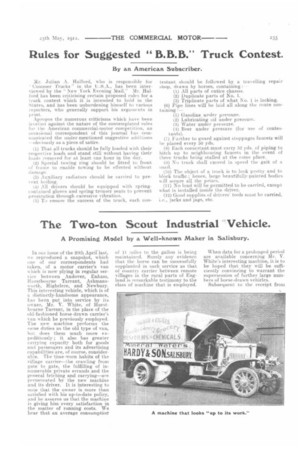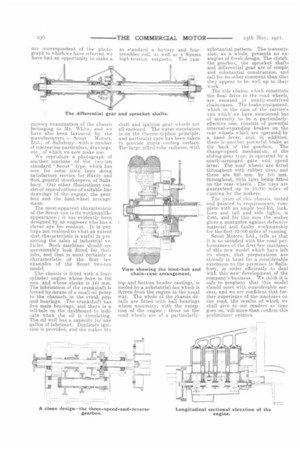The Two-ton Scout Industrial Vehicle.
Page 5

Page 6

If you've noticed an error in this article please click here to report it so we can fix it.
A Promising Model by a Well-known Maker in Salisbury.
In our issue of the 20th April' last, we reproduced a snapshot, which one of our correspondents had taken, of a motor carrier's van which is now plying in regular service between Andover, Enham, rstbourne Tarrant, Ashmansworth, Highclere, and Newbury. This interesting vehicle, which is of a distinctly-handsome appearance, has been put into service by its owner, Mr. V. White, of Hurstbourne Tarrant, in the place of the old-fashioned horse-drawn carrier's van which he previously employed. The new machine performs the same duties as the old type of van, but does them much more expeditiously ; it also has greater .carrying capacity both for goods and passengers and its advertising capabilities are, of course, considerable. The time-worn habits of the village carrier—the crawling from gate to gate, the fulfilling of innumerable private errands and the general fetching and carrying—are peruenuated by the new machine and its driver. It is interesting to note that the owner is more than satisfied with his up-to-date policy, and he assures us that the machine is giving him every satisfaction in the matter of running costs. We hear that an average consumption
of 11 miles to the gallon is being maintained. Surely any evidence that. the horse can be successfully supplanted in such service as that of countrA carrier between remote villages in the rural parts of England s remarkable testimony to the class of machine that is employed.
When data for a prolonged period are available concerning Mr. V. White's interesting machine, it is to be hoped that they will be sufficiently convincing to warrant the supersession of further large numbers of horse-drawn vehicles.
Subsequent. to the receipt from
our correspondent of the photograph to which we have referred, we have had an opportunity to make a
cursory examination of the chassis belonging to Mr. White, and we have also been favoured by the manufacturers — Scout Motors, Ltd., of Salisbury—with a. number of interesting particulars, drawings, etc., of which we now make use.
We reproduce a photograph of another machine of the two-ton standard " Scout." type, which has now for some time been doing satisfactory service for Hardy and Son, general storekeepers, of Salisbury. Our other illustrations consist of reproductions of suitable line drawings of the engine, the gearbox and the hind-wheel arrangement.
The most-apparent characteristic of the Scout van is its workmanlike appearance ; it has evidently been designed by an engineer who has a clever eye for contour. It is perhaps not realized to what an extent that characteristic is useful in promoting the sales of industrial vehicles. Such machines should unquestionably look fitted for their jobs, and that is most certainly a characteristic of the first few examples of the Scout. two-ton model.
The chassis is fitted with a fourcylinder engino whose bore is 102 rum, and whose stroke is 140 mm. The lubrication of the crankshaft is forced by means of a small oil pump to the channels in the crank pins and bearings. The crankshaft has five main bearings, and there is a tell-tale on the dashboard to indicate when the oil is circulating. The oil well has a capacity for one. gallon of lubricant. Duplicate ignition is provided, and the maker fits
as standard a battery and fourtrembler coil, as well as a Simms high-tension magneto. The cam
shaft and ignition gear wheels are all enclosed. The water circulation is on the thertno-syphon principle, and particular care has been taken to provide ample cooling surface. The large gillechtube radiator, with
top and bottom header castings, is cooled by a substantial fan which is driven from the engine in the usual way. The whole of the chassis details are fitted with ball bearings where necessary, with the exception of the engine ; those on the road wheels are of a particularly substantial pattern. The transmission, as a whole, presents no examples of freak design. The clutch, the gearbox, the sprocket shafts and differential gear are of simple and substantial construction, and call for no other comment than that, they appear to be well up to their work.
The side chains, which constitute the final drive to the road wheels, are encased in neatly-contrived chain cases. The brake equipment, which in the case of the carrier's van which we have mentioned has of necessity to be a particularlyeffective one, consists of powerful internal-expanding brakes on the rear wheels which are operated by a band lever, and, in addition, there is another powerful brake at the back of the gearbox. The change-speed mechanism, of the sliding-gear type, is operated by a neatly-arranged gate and speed lever. The road wheels are fitted throughout with rubber tires, and these are 820 mm. by 100 min. throughout, twin tires being fitted on the rear wheels. The tires are guaranteed up to 10,000 miles of running by the makers.
The price of this chassis, tested and painted to requirements, complete with an ample tool-kit, jack, horn and tail and side lights, is 2485, and for this sure the maker gives a guarantee against defective material and faulty workmanship for the first 10,000 miles of running.
Scout Motors, Ltd., tells us that it is so satisfied with the road performances of the first few machines of this new model which have left its shops, that preparations are already in hand for a considerable extension to the premises in Salisbury, in order efficiently to deal with this new development of the company's business. We think it is safe to prophesy that this model should meet with considerable success, and we are confident that further experience of the machines on the road, the results of which we shall give to our readers as time goes on, will more than confirm this preliminary opinion.






















